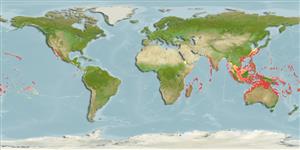Common names from other countries
Environment: milieu / climate zone / depth range / distribution range
Ecologia
marinhas associadas(os) a recifes; intervalo de profundidade 5 - 132 m (Ref. 89467), usually 6 - 30 m (Ref. 9710). Tropical; 32°N - 32°S
Indo-West Pacific: East Africa to the Hawaiian and Rapa Islands, north to southern Japan, south to Lord Howe Island. Southeast Atlantic: sometimes reaching the southeast coast of South Africa (Ref. 3141).
Tamanho / Peso / Idade
Maturity: Lm ? range ? - ? cm
Max length : 23.0 cm TL macho/indeterminado; (Ref. 3141)
Espinhos dorsais (total): 0; Raios dorsais moles (total): 9; Espinhos anais 0; Raios anais moles: 9. Caudal fin rays 10. Strong spine on middle of dorsal ridge.
Inhabit clear outer lagoon and seaward reefs (Ref. 1602). Benthopelagic over rubble and sand at 5-132 m (Ref. 58302). Solitary (Ref. 90102). Males are highly territorial (Ref. 9710). Poisonous in some parts of the tropics (Ref. 7364).
Life cycle and mating behavior
Maturidade | Reprodução | Desova | Ovos | Fecundidade | Larvas
Myers, R.F., 1991. Micronesian reef fishes. Second Ed. Coral Graphics, Barrigada, Guam. 298 p. (Ref. 1602)
Categoria na Lista Vermelha da IUCN (Ref. 130435)
CITES (Ref. 128078)
Not Evaluated
Ameaça para o homem
Venomous
Utilização humana
Pescarias: sem interesse; Aquário: Espécies comerciais
Mais informação
ReferênciasAquaculturaPerfil para aquaculturaEstirpesGenéticaElectrophoresesHereditariedadeDoençasProcessamentoMass conversion
Ferramentas
Relatórios especiais
Descarregue XML
Fontes da internet
Estimates based on models
Preferred temperature (Ref.
115969): 24.3 - 28.8, mean 27.5 (based on 776 cells).
Phylogenetic diversity index (Ref.
82804): PD
50 = 0.5625 [Uniqueness, from 0.5 = low to 2.0 = high].
Bayesian length-weight: a=0.03548 (0.01700 - 0.07404), b=2.81 (2.62 - 3.00), in cm Total Length, based on LWR estimates for this (Sub)family-body shape (Ref.
93245).
Nível Trófico (Ref.
69278): 3.0 ±0.0 se; based on diet studies.
Resiliência (Ref.
120179): Elevada, tempo mínimo de duplicação da população menor que 15 meses (Fec assumed to be > 10,000).
Fishing Vulnerability (Ref.
59153): Low vulnerability (13 of 100).
